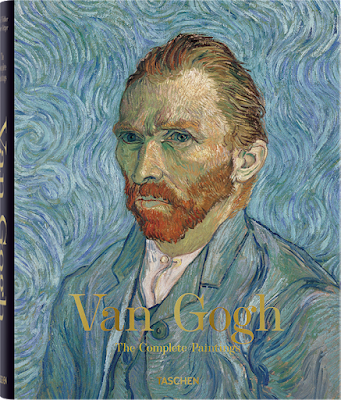When it arrived I realized that it was huge. Over 750 pages not including index and oversized pages. As I started to read it though, I was struck by facts that I did not know and I already had a number of books about him, including his letters. I glanced through the letters but never sat down to read them.
I knew he was the second son born with the name Vincent but did not know he was born on the same day as his brother's stillborn death. There was a small cemetery in front of the vicarage house he grew up in and each day he could see his name sake's headstone.
His was a tortured journey that we have all heard about. But seeing all, not some of his paintings showed his slow but steady development as an artist. None of his work in Holland and with the miners in Belgium showed the brilliance that was to come. The authors of this book call his THE POTATO EATERS his first masterpiece but also note that it is a set piece, each face has been posed and that it was not truly an actual scene. Yet, in its own way, captured the essence of their lives.
My introduction to Vincent was as a 5th-6th Grader taking art classes at the Portland Art Museum. My
 |
| Blossoms: Almond Tree In Bloom |
The Los Angeles County Museum of Art had a show a few years back on Expressionism. The first painting you saw, one the curator worked five years to get and use, was a van Gogh painting. She felt that he represented the beginning of a movement of artists who went beyond the Impressionists and created what was called Expressionism. She had a point.
It is clear that when Vincent went to Paris his painting palette changed but his style became more forceful, more distinct. Yes, he dallied with Signac and Seurat's Pointillism, and some of Cezanne's increasing abstract's. He was enamored with Japanese wood block prints, even organizing a show of them, but all in all he was faithful to his own style. There was no one painting as he did.
The world's second most recognized painting, behind Leonardo's MONA LISA, is Vincent's STARRY NIGHT that now resides at MOMA in New York City. While I think it belongs in Amsterdam, we are lucky that we need only go to New York City to see one of man's most recognizable masterpieces. I read somewhere that astronomers say he even has the stars right the night it was painted. The painting is not huge, like say Seurat's SUNDAY AFTERNOON ON THE GRAND JATTE, but to stand in front of it you find yourself drawn into the swirls, even floating above the town in blue and yellow splendor.
 |
| THE RED VINEYARD by Vincent van Gogh |
He was forever grateful to Theo who in fact had most of the paintings stored in a warehouse and would now and then enter them into show competitions. The first two paintings that were ever shown were THE POTATO EATERS and IRISES that is now in the Getty Center in Los Angeles.
 |
| IRISES by Vincent van Gogh |
My family and I went out to see IRISES but we could not locate it anywhere. It was the first such painting the Getty had ever bought and looking back, there was really no room to hang it in. Finally giving up my kids found the new media room with Wi-Fi and 20-30 computers all hooked up. My 10 or so year old son immediately latched on to one and my daughter and I looked around the room. I spotted a painting at the end of the room almost in total darkness and walking towards it realized here was the van Gogh. The woman in charge came up and asked me if I knew what it was. Speechless I just nodded. Getting closer she turned on the lights and I probably gasped. Looking at it I said, "I certainly have a better place to hang it than here!" "Where?," she asked. "My living room over my fireplace." After a good laugh she explained the dilemma they were having on hanging it. It was then and remains today one of my favorite paintings.
Vincent knew many of what are now famous Impressioinists of the day and lived for a short time with Gauguin. They were too different in style and temperament. He learned from and somewhat copied all their styles yet never let his own go. He was aware of own style and was liked by his fellow painters.
The mental breakdowns hit him hard and yet during his time in St. Remy and outside of Paris, in Arles, where he died, he produced some of his greatest masterpieces. Painting usually outdoors there is an amazing video on YouTube where they have found bugs, always a constant threat, buried deep in his paint. After he came back to the north of Paris, just before he died, he painted 80 paintings in 60 days. Many are considered some of his finest masterpieces.
 |
| WHEAT FIELD WITH CROWS by Vincent van Gogh |
Thank you for reading my blog. I invite you to take the time to read earlier blogs where my emphasis is to explore the ways art and design affects our daily lives ... and always has. I share with you what inspires me with the hope that it will inspire you as well. Comments are always welcomed!
Be sure to check my ETSY store ... KrugsStudio.etsy.com. I am adding many new and exciting, collectible birdhouses and craft items. Many of the items talked about here will be for sale there!



No comments:
Post a Comment